Piles, also known as hemorrhoids, are a common health issue affecting many women. They occur when veins in the lower rectum or anus become swollen, leading to discomfort and pain. This condition can cause symptoms of piles like itching, bleeding, and swelling around the anus.
This article will discuss the top 5 symptoms of piles in females and explore simple treatment options to help manage the condition effectively.
Recommended Reading: How To Relieve Constipation On The Toilet Immediately (Naturally)
Top 5 Symptoms Of Piles In Females (Symptoms & Cure)
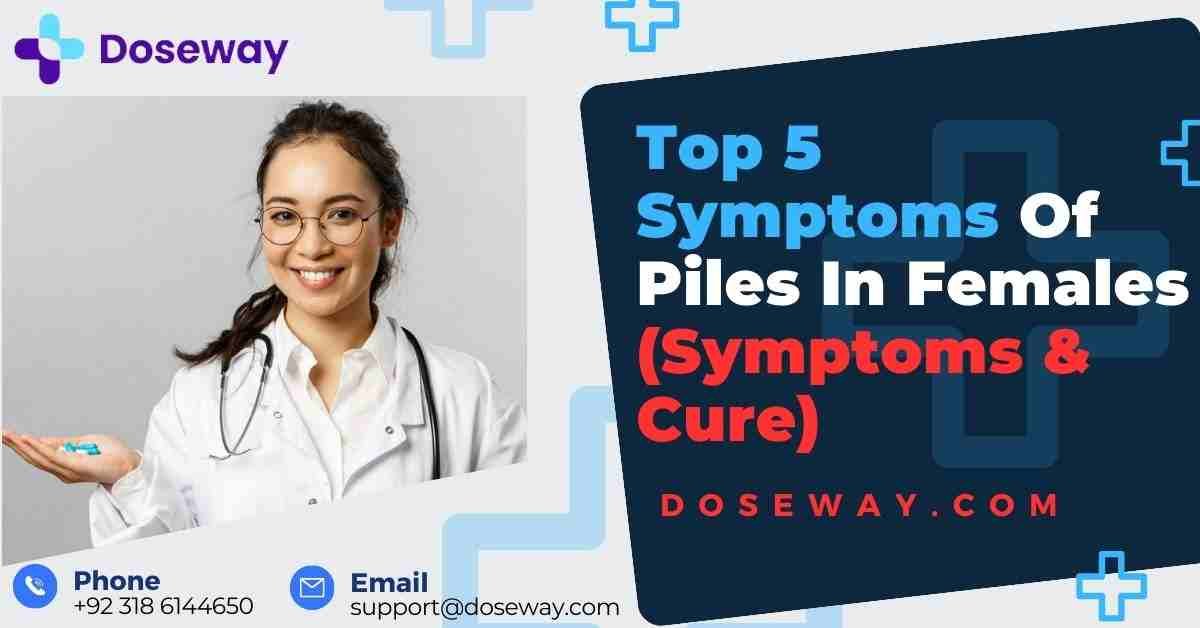
Table Of Contents
Recommended Reading: Top 5 Constipation Relief Medicines For Babies
What is Piles?
What are the Symptoms Of Piles?
The symptoms of piles include itchy anus, pain and discomfort, rectal bleeding, swelling or lumps around the anus, and mucous discharge with soreness, causing irritation and difficulty during bowel movements.
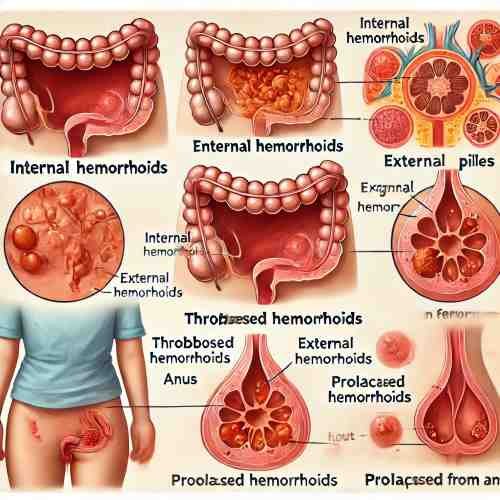
Piles, also called hemorrhoids, are swollen blood vessels found in or around the rectum and anus. They can lead to discomfort, pain, itching, and even bleeding, especially during bowel movements.
Types of Piles:
- Internal Hemorrhoids: Swollen veins inside the rectum.
- External Hemorrhoids: Swollen veins under the skin around the anus.
- Thrombosed Hemorrhoids: External piles that develop blood clots.
- Prolapsed Hemorrhoids: Internal hemorrhoids that have fallen out of place and protrude from the anus.
Causes of Piles in Females:
- Straining during bowel movements.
- Pregnancy.
- Chronic constipation or diarrhea.
- Lack of dietary fiber.
- Sitting for long periods.
Recommended Reading: Alternative Medicine For Joint Pain (Knee Pain Treatment)
Top 5 Symptoms of Piles in Females
Top Symptoms of Piles in Females
The top symptoms of piles in females include itchy anus, pain and discomfort while sitting or passing stool, rectal bleeding with bright red blood, swelling or small lumps near the anus, and mucous discharge causing soreness and irritation.
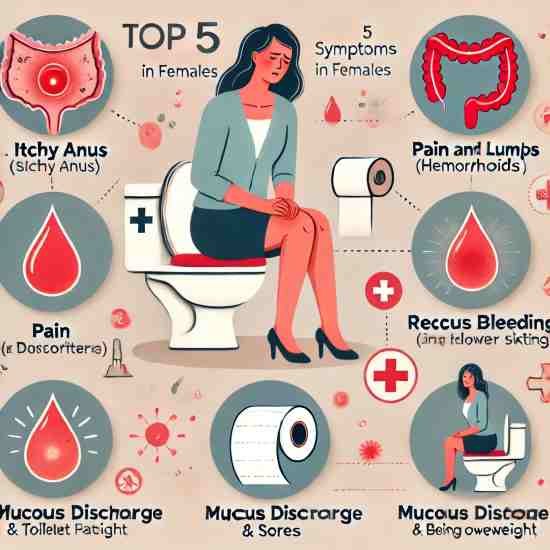
Piles, also known as hemorrhoids, can cause several uncomfortable symptoms in females. Below are the five most common signs to look out for:
- Itchy Anus: Females with piles may experience constant itching around the anus due to irritation and inflammation.
- Pain and Discomfort: There may be pain during bowel movements, and sitting for a long time can also cause discomfort, especially if the hemorrhoids are severe.
- Rectal Bleeding: Bright red blood may be noticed during or after passing stool, a common sign of piles.
- Swelling or Lumps: Swelling or small lumps can form around the anus, particularly with external hemorrhoids, making it uncomfortable to sit or move.
- Mucous Discharge & Soreness: A mucous discharge may occur, causing soreness and further irritation in the anal area.
Who Should Be Concerned?
Women are more likely to experience piles during certain stages of life or due to specific habits. The following factors can increase the risk:
- Pregnancy
- Being overweight
- Sitting for long periods
It’s important to seek medical advice if you notice any of these symptoms of piles:
- Persistent bleeding
- Severe pain during bowel movements
- Difficulty passing stool despite trying home remedies
Recommended Reading: Stomach Acidity Medicine (Medicine For Acidity & Gas)
Cures and Treatment Options for Piles in Females
Cures and Treatment Options for Piles in Females
Effective treatment options for piles in females include home remedies, OTC treatments, and medical procedures for lasting relief.
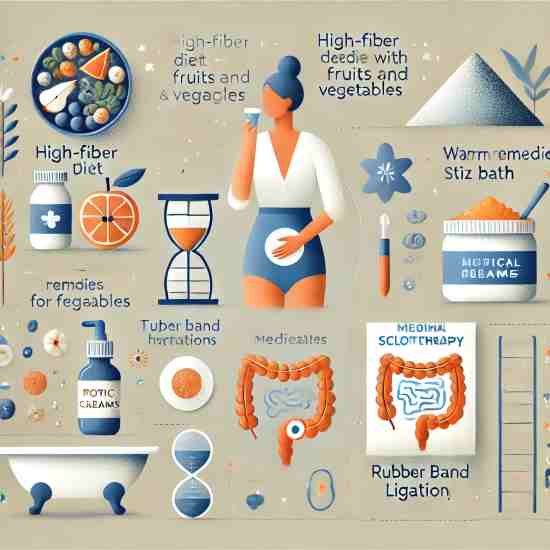
There are several ways to treat symptoms of piles, depending on their severity. Treatment options include:
Home Remedies
- High-Fiber Diet: Eating foods rich in fiber helps prevent constipation and reduces strain.
- Hydration: Drinking plenty of water softens stools, making bowel movements easier.
- Warm Sitz Baths: Soaking the anal area in warm water can relieve pain and reduce swelling.
Over-the-Counter Treatments
- Topical Creams: These can help reduce itching and discomfort.
- Pain Relief Medications: Over-the-counter pain relievers can reduce pain during bowel movements.
Medical Treatments
- Rubber Band Ligation: A procedure where a small rubber band is placed around the piles to cut off their blood supply, causing them to shrink.
- Sclerotherapy: An injection treatment used to shrink hemorrhoids.
- Surgery: In severe cases, surgery may be necessary to remove large or painful piles.
Recommended Reading: Over The Counter Asthma Tablets (Best Medicine For Asthma Cough)
Pros & Cons of Treatment Options
When treating these symptoms of piles, there are different options, each with its benefits and drawbacks. Here’s a breakdown:
Home Remedies
- Pros:
- Affordable and easy to try.
- No need for medical prescriptions.
- A natural approach to managing symptoms.
- Cons:
- May take time to show noticeable results.
- Might not work for severe cases.
Over-the-Counter Creams & Medications
- Pros:
- Provides quick relief from pain and itching.
- Readily available at pharmacies.
- Cons:
- Some creams may cause irritation or allergic reactions.
- A temporary solution, may not address the root cause.
Surgical Treatments
- Pros:
- Offers a permanent solution for severe piles.
- Effectively removes or shrinks hemorrhoids.
- Cons:
- Can be painful with a longer recovery time.
- Surgery carries the risk of complications.
Recommended Reading: Alternative Medicine For Knee Pain Treatment
Effectiveness of Piles Treatments
The effectiveness of piles treatments depends on the severity of the condition. Here’s how different treatments work:
Home Remedies
- Effectiveness:
- Works best for mild cases.
- Simple changes like a high-fiber diet and staying hydrated can reduce symptoms like pain, swelling, and discomfort.
- Most people notice improvement within a few days.
Medical Treatments
- Effectiveness:
- For moderate cases, treatments like topical creams, pain relief medications, and sclerotherapy can provide significant relief.
- These treatments may take a little longer to show full effects compared to home remedies.
Surgical Treatments (Hemorrhoidectomy)
- Effectiveness:
- Highly effective for severe or chronic piles.
- Often provides permanent relief by removing or shrinking the hemorrhoids.
- Recovery time can range from 2-4 weeks but results in long-lasting relief from symptoms.
Prevention Tips for Females
Prevention Tips for Females
Simple lifestyle changes like eating fiber-rich foods, staying hydrated, and avoiding prolonged sitting can help prevent piles in females.
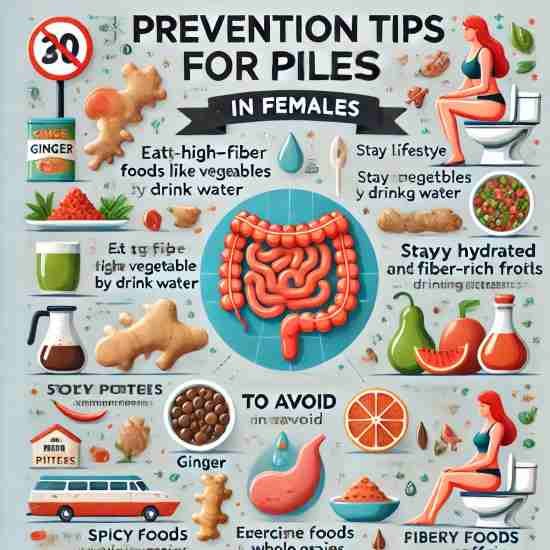
Preventing piles can be easier than you think with a few lifestyle adjustments. Here are some key tips:
1. Eat High-Fiber Foods
- Include fruits, vegetables, and whole grains in your diet.
- High fiber helps keep stool soft and reduces straining during bowel movements.
2. Stay Hydrated
- Drink plenty of water throughout the day.
- Consuming watery foods like watermelon can prevent constipation and promote smoother bowel movements.
3. Exercise Regularly
- Physical activity helps with digestion and circulation.
- Regular exercise can prevent constipation and reduce pressure on the rectal area.
4. Avoid Prolonged Sitting
- Take breaks to walk around every 30 minutes to an hour.
- Sitting for long periods can put pressure on the rectum and increase the risk of developing piles.
Foods to Eat & Avoid for Piles
When managing piles, your diet plays a crucial role in easing symptoms and preventing flare-ups. Here’s a list of foods to eat and avoid:
Foods to Eat:
- Ginger
- Helps reduce inflammation and soothe the digestive system.
- Lean Proteins
- Support faster recovery and tissue repair.
- Whole Grains & Oatmeal
- High in fiber, these foods prevent constipation and ease bowel movements.
- Bananas, Melons, Apples, & Vegetables
- Rich in fiber and water, they make stool softer and easier to pass, reducing strain.
Foods to Avoid:
- Spicy Foods
- Can irritate the digestive tract and worsen symptoms.
- Alcohol
- Can contribute to dehydration, leading to constipation and discomfort.
- Caffeine
- May irritate the digestive system and can also cause dehydration.
Recommended Reading: Top 5 Constipation Relief Medicines For Babies
FAQs
What are the common symptoms of piles?
The main symptoms of piles include itching around the anus, pain during bowel movements, swelling or lumps near the anus, and rectal bleeding. Some people may also experience a mucous discharge.
How can I tell if I have piles?
If you notice bright red blood in your stool or on toilet paper, experience pain while sitting or during bowel movements, or feel itching or swelling around your anus, these could be signs of piles.
Is rectal bleeding always a Symptoms of piles?
Not always. While rectal bleeding can be a symptom of piles, it can also be a sign of other conditions like anal fissures or gastrointestinal issues.
Can piles cause pain while sitting?
Yes, piles, especially external ones, can cause discomfort or pain when sitting for long periods. The pressure on swollen blood vessels around the anus can make sitting uncomfortable.
Are the symptoms of piles the same for everyone?
No, symptoms of piles can vary from person to person. Some may only experience mild itching or discomfort, while others may have more severe symptoms like bleeding, pain, and swelling.
Can symptoms of piles go away on their own?
In mild cases, piles may go away with home remedies like a high-fiber diet, hydration, and over-the-counter treatments. However, if symptoms of piles persist or worsen, it’s important to seek medical advice.
Should I see a doctor if I have symptoms of piles?
Yes, if you experience persistent symptoms like bleeding, severe pain, or difficulty passing stool, it’s a good idea to consult a doctor.
Recommended Reading: Best Medicine For Stomach Acidity & Gas
Conclusion
Piles are a common problem for women, particularly during pregnancy, and can cause significant discomfort. The key symptoms to watch for include rectal bleeding, pain, itching, and swelling.
To manage these symptoms, a combination of a healthy diet, staying hydrated, and using topical treatments can be very helpful. For more severe cases, medical procedures or surgery might be required.
If you are experiencing piles, it’s a good idea to start with home remedies. However, if symptoms persist or worsen, seeking advice from a doctor is important for proper treatment.
………………………….
Disclaimer:
Commissions we earn from partner links on this page do not influence our content. Our editorial content is based on thorough research and insights from qualified medical professionals to ensure the highest standards of accuracy and reliability.
Information provided on Doseway is for educational purposes only. Your health and wellness are unique to you, and the products and services we review may not be suitable for your circumstances. We do not offer personal medical advice, diagnosis, or treatment plans. For specific advice, please consult with a healthcare professional. Doseway adheres to strict editorial integrity standards. To the best of our knowledge, all content is accurate as of the date posted, though offers and information may change. The opinions expressed are the author’s own and have not been influenced, approved, or endorsed by our partners.
…………………………….

 Cart is empty
Cart is empty
Add a Comment